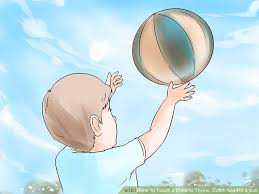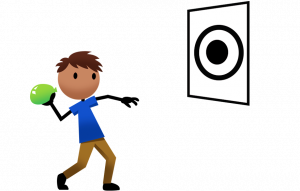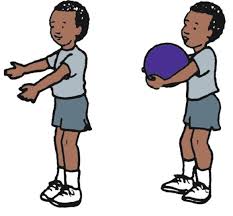Let’s Have a Catch!!!
Playing catch in the backyard can be a fun activity to do with your children. However, for some children, having a catch is very difficult due to poor coordination, inability to judge the distance and speed of a moving object, difficulty sustaining visual pursuit of the object, and a fear of being hit by the ball.
Typically, when first learning to catch, a child will stand with their arms extended out straight in front of them in anticipation of the ball coming toward them, and will catch the ball by wrapping their arms around the ball and trapping it with their body.
The child will then throw the ball back to you using the whole arm, keeping the elbows straight, and using either an overhand or underhand motion.
If your child is afraid of the ball, or is unable to focus on the activity, using an object that moves more slowly will help them to get started. You might start by using a light weight scarf. If you drop the scarf from above your child’s head, your child will have time to watch the scarf drop down and then reach with 2 hands to catch it. You can then try tossing the scarf to your child in a gentle floating arc from about 3-4 feet away. Other good items to start with are balloons, small beach balls, and under-inflated balls that will have some give to them, as little hands try to catch them.

As children get more coordinated they will be better able to catch a ball by anticipating its weight and size. They will stand with their elbows bent and arms as far apart as needed to accommodate the size of the ball you are tossing. You can cue your child to get “ready” and assist them to bend their elbows a little while waiting to catch the ball. Experimenting with balls of many different sizes, shapes, weights, and textures will help develop eye-hand coordination. Vary the distances that you are tossing from
By the end of the fourth year look for your child to be able to catch a playground ball using just their hands, without hugging the ball to their bodies. Your child should also be able to throw a ball from their chest, with the elbows bent instead of using a whole arm motion.
Four year olds are able to learn to throw a smaller ball of about 4” in size with good coordination. Over
hand throwing usually develops first. Initially, the throwing is done with the arm only. After a little more practice the arm will develop a backswing before throwing. The child will start to shift their weight forward while throwing by stepping forward with one foot to get more power into the throw. By 5 years old the child will start to step forward with the foot on the opposite side of the body.
Underhand throwing is the most difficult type of throw for a 4 year old to learn. Often the child who is beginning to throw underhand will use a side-arm motion. Cue them to hold the ball at their side with the “thumb on top”. Start with a very short distance from the target to insure more success. As throwing improves, you can place hula hoops on the floor or wall to serve as targets to improve eye-hand coordination.
